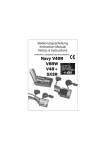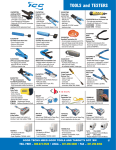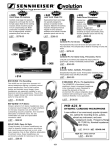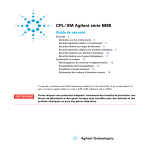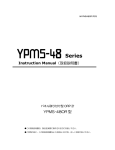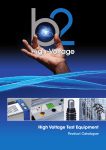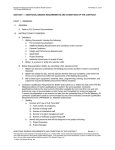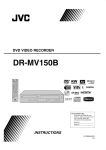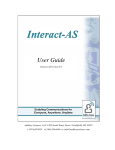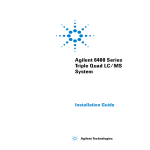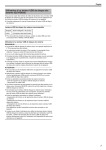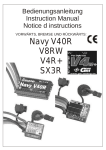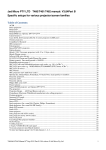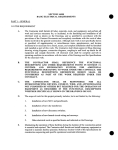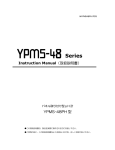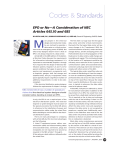Download PART 1—GENERAL - Delano Joint Union High School District
Transcript
DELANO HIGH SCHOOL PROJECT NAME: DHS YR15 VIDEO SYSTEM PART 1—GENERAL 1.01 SCOPE OF WORK A. This is a Request for Proposal for Delano High School. This is an e-rate year 15 project. All bids should be broken out into e-rate eligible and non e-rate eligible parts and pricing. A lump sum bid will not be accepted. Vendor shall provide a complete detailed bid as per FCC and e-rate bidding procedures. B. The Contractor shall furnish all labor, project management, materials, tools, equipment, and resources necessary for the installation, startup, and testing of the system shown on the plans and described in the specifications. C. The system shall be a broadband system as set forth in the plans and specifications. The Contractor shall furnish and install the system as defined by the plans and specifications. The Contractor must demonstrate to the Owner that the system is complete and complies with all operational requirements set forth in the plans and specifications. The Contractor shall provide all miscellaneous items and accessories required to make the system operational whether or not such items are specifically mentioned in the plans and specifications. It is the Contractor’s responsibility to review the architectural, structural, mechanical, and electrical drawings, as well as the specifications, for any details that may impact the installation or provisioning of the system. Any discrepancies discovered shall be brought to the attention of the engineer and Owner. D. The system shall provide instructors the ability to search, schedule, and control media that will be centrally located and distributed to multiple sites. The system database shall maintain specific information on media titles along with instructors for all buildings. The system must also allow (100) concurrent internet/intranet users. The system must connect to the district Local and Wide Area Network. E. The system shall provide instructor’s access, scheduling and manual or automatic control of (4) DVD/VCR Combo, (8) off the air, and the video server. F. The system shall provide encoding, access, scheduling and manual or automatic control of MPEG1 or MPEG2 video. The system shall be capable of Video IP Multicasting over the IP network. G. The system shall provide hardware to encode video directly into native MPEG1 or MPEG2 formats using resolutions of 352 x 240 up to 740 x 480. Systems that use software encoding methods or convert avi files or MJPEG into MPEG will not be acceptable. H. The System must support the delivery of HDTV video to the classroom. 1 I. All software operating system/application software licenses must be provided with proposed systems. J. The Contractor shall provide and install a Media and Resource Management System consisting of audiovisual (AV) media control, a distribution system and environmental interfaces. The system shall allow scheduling of analog and digital media sources for viewing and control at each destination. K. The system shall handle all routing requirements in order to distribute media content from a centralized location (hereafter referred to as the ―Head End‖ or ―Media Center‖) to all destinations. L. All scheduling activities shall be controlled via a Media Center computer that shall be supplied with all necessary scheduling and system management software specified herein. M. The Media Center computer system shall, in addition to scheduling, issue commands to machine control devices for the execution of scheduled requests. N. All communication between the Media Center computer and the control system shall occur via TCP/IP. O. The System shall operate in a distributed processor environment with independent microprocessors provided in the Media Center computer, the control system, and the Television Managers (hereafter referred to as ―TMs‖), if applicable. P. All processors shall manage and share data over a managed digital data network. Q. Users shall have the option of using a select set of control options ranging from web clients to touch sensitive color video panels and handheld infrared (hereafter referred to as ―IR‖) remotes. R. Destinations shall have audio and video data delivered across a controlled sub-net. Modes of distribution must allow for AV baseband, RF broadband, and digital distribution methods, including support for mixed routing whereby broadband and baseband topologies may be employed within the same system. Systems not able to be configured for any of these methods shall be deemed unacceptable. S. The Digital Video Server shall be HP ProLiant ML350 G6 Large Form Factor - Rack Server 1.02 ALTERNATE SYSTEMS A. System features outlined in these specifications are those deemed mandatory for successful operation and functionality of the system. This Grass Valley Media Edge system is designed to integrate to the district wide Media Edge Distribution System. The specifying authority must approve any performance or functionality deviations from these specifications. Bidders wishing to submit alternate systems shall submit documentation containing information to allow the specifying authority to determine that the proposed system meets or exceeds the system performance and functionality specified herein. The documentation must be 2 submitted 10 days prior to the bid opening. The documentation shall contain at least the following information: manufacturer’s specification sheets, functional block diagrams, installation documentation, user manuals, regulatory agency compliance registration, and typical wiring diagrams. The bidder shall also be capable of providing a system demonstration that demonstrates the features outlined in the specifications. B. Approval to bid shall not release the Contractor from full specification compliance requirements. Final system acceptance testing shall govern final system acceptance and compliance with the specifications. C. Failure to provide a functional equivalent shall result in the removal of the alternate system at the contractor’s expense. 1.03 SIMILAR INSTALLATIONS A. All bidders must provide a listing of 3 similar size projects having the same scope of work using the proposed information delivery equipment. This listing shall be complete with facility names, completion dates, names of contacts, and their telephone numbers. 1.04 CONTRACTOR EXPERIENCE A. All bidders must provide a listing of all projects they have installed during the last 36 months that have the same scope of work as the information delivery system being proposed. Any installations that have been subcontracted will not be accepted. 1.05 SUBMITTALS A. The successful bidder shall prepare five copies of a complete system submittal package. The successful bidder shall submit manufacturer’s specification sheets on each type of equipment proposed for use in the system. Each specification sheet provided shall be clearly marked to indicate the exact item provided. The submittal package shall include a system functional block diagram and a system riser diagram showing interconnection of all major equipment and devices required for an operational system. The submittals shall include scaled drawings indicating front and rear views of all equipment racks, consoles, and associated equipment including the relative position of the equipment, terminal connections, descriptive title, manufacturer, and model number. The submittals shall include complete drawings indicating the interconnection of all equipment within the MDF and IDF(s). The submittals shall include complete line drawings indicating coaxial and control cable distribution with locations and values of taps indicated and overlaid on floor plans. The submittals shall have a title block that includes a descriptive title along with all subparts of each name of the project, the architect’s name, and the name of the contractor. All drawings in the submittals shall be produced using AutoCAD version 2000 or higher. The submittals shall include written confirmation from the manufacturer that the bidder is an authorized representative for the submitted product. 1.06 CONTRACTOR QUALIFICATIONS The bidder shall, submit with the bid at least the following information to verify that the bidder has the necessary experience and qualifications to perform the specified work: 3 A. A detailed brochure describing the firm’s capabilities, present agreements with specified manufacturers or the manufacturer’s representatives that they are authorized to install the specified equipment; B. Certify that all work shall be performed by an experienced audio systems engineering contractor having at least 10 years direct experience with the components, devices and equipment specified herein and of similar scope; C. Certify that the contractor shall have been a factory authorized engineering contractor for all products specified herein for at least the last 2 years at the time of the bid. D. Certify that the contractor shall maintain a staff of qualified technicians able to respond to service requests and shall be located within 75 miles of the jobsite. At least one staff technician shall have a minimum of 5 years experience servicing the products specified herein at the component level; E. Certify that the contractor shall be a licensed California contractor holding a C-7 class license; F. Certify that the contractor shall be involved solely with the engineering and installation of audio, video and control systems consistent with the scope of work described herein and as shown on the drawings. G. Certify that the contractor maintains on staff the services of NICET trained technicians. At least 15% of all installers and technicians who work on this project must have passed and received at least a Level 1 NICET Audio Systems certificate. The lead technician must possess a NICET Level II Audio Systems certificate or higher. Copies of each certificate shall be included in the Bidder’s documents on the day of the bid and in the Contractor’s prebid submittal; H. Certify that all installation technicians have at least 2 years direct experience with systems installations of similar scope. J. Certify they are bidding the specified equipment with no deviations. Substitutions shall not be considered or approved after the bid unless the equipment is no longer available at the time the equipment is ordered; K. Provide a list of installations representing similar scope of work successfully completed over the last 2 years. A minimum of 2 installations is required. Include project name, project address, project architect, project consultant, owner’s contact, phone number, and level of responsibility of contact with relation to the direct involvement of the system's operation; L. And provide a list of product lines that the contractor is factory authorized to install, provide, and service. M. The contractor shall be an authorized factory agent or distributor of the proposed system. An electrical contractor shall not be acceptable unless proof of factory qualification is provided with the bid documents. The system provider shall have ready access to spare parts. A documented minimum of five years’ experience in the application of similar systems and 4 equipment is required. All bidders shall provide contact names and résumés of the project management team that will be responsible for this project. N. The Integrated Systems Contractor (Factory Authorized Dealer) must certify that it maintains on staff the services of Certified Electronic Systems Technicians (C-EST) trained technicians. At least 15% of all installers and technicians who work on this project must be a Certified Electronic Systems Technician. The lead foreman (C-EST) shall have a minimum of five (5) years experience in installation of these types of systems and shall be factory authorized to work on the specified systems. O. The Integrated Systems Contractor (Factory Authorized Dealer) shall also maintain on staff or provide the services of a Registered Communications Distribution Designer (RCDD). The RCDD shall have a minimum of five (5) years experience in infrastructure design. The RCDD shall review, approve, and stamp all infrastructure design documents to insure compliance with National Communications Standards and Practices as outlines by BICSI (Building Industry Consulting Service International), CEC (California Electrical Code), and any state and local requirements. The name, address, and telephone number of the RCDD assigned to this project must be included in the Contractor’s documents and subsequent submittal package. District may waive this requirement depending on vendor knowledge of district installation practices and policies. 1.07 PROVIDE A. Where the word ―Provide‖ is used, it shall be defined as requiring the furnishing and installing of the item or facility indicated, complete in all respects and ready for operation, unless otherwise specifically noted. 1.08 GUARANTEE A. The Contractor shall guarantee all work and equipment for a period of two years from the date of system acceptance or beneficial usage by the Owner. Neither the final payment, nor any provisions in the contract documents, shall relieve the Contractor (or General Contractor) of the responsibility for faulty materials and/or workmanship for a period of two years. This Contractor shall remedy any defects due thereto, and pay for any damage to work resulting there from. B. The Contractor shall employ factory-trained technical/service personnel for service and maintenance of the system. Their résumés will be required. The factory-trained technical/service personnel shall have a minimum of two years experience installing the proposed system. The Bidder shall submit the names and copies of the certificates issued by the factory. The Contractor shall instruct the Owner’s technical personnel in the operation, care, and maintenance of the system. 1.09 REGULATORY AGENCY COMPLIANCE A. UL Listing 5 All material and equipment shall be clearly listed, labeled, or certified by Underwriters Laboratories, Inc. All power supplies and computers shall be clearly UL Listed. Any system, which is not UL Listed at time of bid, will be rejected. B. FCC Compliance All acceptable systems shall be approved under Part 15, Subpart B, Section 15.107b of the FCC Rules and Regulations. Bidders must provide the FCC Registration Number of the proposed system. Systems that are not in compliance with the FCC will not be considered. Any system that is not FCC compliant at time of bid will be rejected. All equipment must be clearly labeled with FCC compliance stickers. C. Local Electrical Codes The system shall be installed in accordance with local and national electrical codes. PART 2—SYSTEM PERFORMANCE CRITERIA 2.01 DESCRIPTION AND CONFIGURATION A. The system shall provide advanced information management, media distribution, remote scheduling, and control capabilities to multiple building locations and individual rooms within multiple buildings. The system consists of the following building blocks: 1. Database Server 2. System Administrator Software 3. Intranet/Internet client software for high performance scheduling and control. 4. Web/Browser Server for scheduling and control. 5. Digital Video Encoding System – Mac Pro, Apple LED Cinema Display, grass valley ADVC, and JVC GZ-HD620B HD Hard Drive Camera. B. The system shall be equipped with an uninterruptible power supply SMX1500RM2U and Network Management Card AP9630. 2.02 DATABASE SERVER, ADMINISTRATOR SOFTWARE, COMMUNICATIONS ROUTER, AND MODULE CONCENTRATOR (HEADEND) A. Database Server 1. The system’s primary headend components are the Database Server, and the System Administrator. The headend must be capable of supporting the following fully interactive system configurations: single headend—single location, multiple headend—multiple locations. The system headend must support control by any of the following methods: infrared control using a handheld remote, desktop computer control, or telephone control. 6 2. The Database Server shall be capable of simultaneously supporting multiple local and multiple remote System Administrator clients on a network. 3. The Database Server shall have an internal clock capable of synchronizing its time to the facility’s master bell clock. 4. The Database Server shall maintain all current schedule information during a power failure and shall place all sources into a stop mode once power is restored. B. System Administrator 1. The System Administrator application software shall use a Microsoft® Windows® Graphical User Interface (GUI) which supports pull-down menus, pop-up menus, and positionable toolbars, allowing the media coordinator or other designated individuals to schedule media source devices for individual rooms. 2. The System Administrator shall allow the media coordinator to schedule and control the system media source equipment and individual room equipment. The scheduling and control software shall recommend and assign source equipment based on usage history and scheduling conflicts. The software shall automatically allocate the least-used media source when multiple units are available and shall not assign any out-of-service media sources to a room. The software shall be able to schedule the use of multiple media source devices to a specific room and provide that room with the ability to control up to eight media source devices within a given time period. 3. Media source equipment shall be selected by the media coordinator and displayed on the schedule screen. Events shall be scheduled by the minute or by period. In systems with a central headend and multiple facility locations, each location shall have the ability to individually set each of the following scheduling parameters: private time/period sets, users, rooms, and resources. The event schedule shall automatically be stored on the Database Server hard disk once the media coordinator establishes the schedule. 4. The system shall support scheduled events by instructor and room or zone. Multiple zone video page events can be scheduled simultaneously and should be able to take place at the same time without disabling the administrator console functions. 5. The system shall support a view room feature that allows single or multiple sources to be scheduled to a ―master‖ room. ―Slave‖ rooms can be linked to the ―master‖ room. All slave rooms will respond to all commands initiated by the master room to multiple sources. 6. Events shall be scheduled by the hour, minute, and by class period. The system shall be capable of recognizing up to 30 class periods and an unlimited number of class period sets. 7. The System Administrator shall allow the media coordinator to define the system schedule using facility class periods, in addition to the standard scheduling feature of one-minute increments. The Database Server shall be capable of storing a full year of class period schedules, assigning these schedules to specific days of the week, and to 7 specific periodically occurring days. Specific schedule assignments shall override regular day of the week schedule assignments. 8. The System Administrator shall provide context-sensitive Help windows accessible from any window through an onscreen Help button. The background color of the Help window shall be different from that of the current screen display. A portion of the original screen display shall remain visible so that the user can relate information on the Help window to commands on the menu. The Help window shall be movable to allow the user to see what is displayed on the screen behind it. The System Administrator shall provide a Windowscompliant GUI that supports pull-down menus, pop-up menus, and positional toolbars. 9. The System Administrator shall request the following information when the media coordinator schedules each media source device for use by a specific room: a. b. c. d. e. f. Identity of the media source device being scheduled Date the device is needed Time of day (hours and minutes) or class period when the device is needed Time of day (hours and minutes) or class period when the device is not needed Instructor requesting the device Room in which the user will be located 10. The System Administrator shall be capable of unblocking global and auxiliary channels controlled by a room and make it available to other rooms. 11. The System Administrator shall be capable of displaying a call-in message from the room to signal the media coordinator that the system user needs assistance. This message shall list all sources scheduled to that room at the time the message is sent, to assist the media coordinator in correcting any operational problems. 12. The System Administrator shall control user access to system operation and maintenance functions using four distinct levels of user-programmable password protection at each facility. 13. Any system that requires an installer to physically enter a room to upgrade the television control module operating system or to change the television control command set shall be unacceptable. All room control module software upgrades must be downloadable from the system headend. 14. The System Administrator shall be capable of displaying and logging (recording) all component communication failures between the room and the system headend. The System Administrator shall be capable of displaying the real-time status of all nodes. The loss of a connection to one facility in multiple-facility systems shall not affect other facilities. 15. The System Administrator shall be capable of scheduling recurring events to take place each week for specific days of the week. Recurring events will continue to add automatically in the schedule and shall be capable of automatic source control features such as ―auto-play‖ and ―auto-rewind‖. 16. A slide bar shall allow the user to adjust the speed of the scrolling of the tables. The value 8 is saved in the users registry database and will be used whenever the user logs in to an SA. 17. The Usage report and form shall display a total value of Count, Scheduled and Actual columns. The Denial report and form shall display a total value for the Count column. 2.03 SYSTEM FEATURES A. Cabling Topologies 1. All scheduling, control, and or delivery of media resources shall be done using the LAN/WAN. All network interfaces, ports, and hubs providing connection of system to LAN/WAN are to be provided with the proposed system. B. System Passwords 1. The System Administrator software application shall provide the ability to maintain an instructor and source equipment database unique to each facility. This system shall have four password levels: Operator, Administrator, Installer, and Client Access. The system shall have a user-defined auto logout function to automatically log users out when the system is left unattended. C. Context Sensitive Help 1. The System Administrator software shall provide context sensitive help on all software components. Context sensitive help windows shall provide the user with help information relevant to the active function. D. System Messaging 1. The system shall provide information and user messaging to the System Administrator. Information and user messaging shall be generated in two ways: by users in the room and by the system. These messages are displayed in a System Messages pop-up box and kept in a system log. Users in the room send messages to the Administrator using the handheld remotes or the Network Client application. The system generates messages in response to various conditions detected by the system software. Each message displays the time and date it was sent. User messages identify the originating room and current resources the room is using. E. System Log 1. The System Administrator software application shall provide a log that records all events that have occurred on the system. The system log records the date, time, type of event, description, user name, room, source, serial device, concentrator, and port. H. Global and Auxiliary Sources 1. The System Administrator software application shall provide the user the ability to define 100 global resources that can be shared by multiple facilities connected to the system. The system shall also allow the definition of 100 auxiliary sources, unique to each facility that is not shared with the other facilities. Global and auxiliary sources may be controllable sources or view-only sources. 9 2. The system shall be capable of adding assigned media to the Auxiliary and Global resources to allow a user to play Digital Video Clips ―One Demand‖. A single clip of a menu of clips can be associated with an Auxiliary or Global resource. By associating a menu to the resource a true ―On Demand‖ digital video feature can be realized. 3. The system shall allow each auxiliary resource to have a room/zone associated with it. The system shall allow different areas of a facility to have different Video on Demand menus and allow VOD by department. Each video zone can be partitioned with its own Video on Demand menu on the digital video server. I. Period- and Time-Based Scheduling 1. The system shall provide a full period- and time-based scheduling of sources. There shall be no limitation to the number of class period sets that can be set up at each facility. A specific period set for any given day shall contain no less than 30 periods and a different period set can be assigned to a different day of the week. The user shall be allowed to schedule period sets one year in advance. If a user selects a class period when scheduling media at the System Administrator or at the room client, the system shall automatically schedule that media for the appropriate time defined by that period. J. Scheduled Sources 1. The system shall provide scheduling up to eight different devices to a single room at the same time by minutes or by periods. Each of the eight different devices shall have a unique position to be scheduled on one of eight key positions on the handheld remote. It shall require only a single keystroke to access any of eight sources directly. Any system that requires multiple keystrokes to access any of the eight scheduled sources shall not be acceptable. 2. The system shall provide the ability of allowing an administrator to set up events that will be automatically added to the schedule event list and run on predetermined days of the week. The administrator can choose any or all days of the week for each recurring event. K. Scheduling Least-Used Sources 1. The system shall automatically select the source device for a scheduled event based on the device with least hours of use with respect to total usage. 2. The system shall provide the ability to schedule an event based on the least number of hours scheduled for that source by day. L. Media and Instructor Records 1. The system shall provide the ability to display the complete record details for a media title or any instructor on the system by double-clicking on the scheduled title or instructor name at any time. M. Automatic Rewind 10 1. The system shall provide the ability to issue an automatic rewind command to a media resource to automatically rewind media when the scheduled event or period is concluded. N. Automatic Play 1. The system shall provide the ability to issue an automatic play command to a media resource to automatically play media when the scheduled event or period begins. O. Automatic Record 1. The system shall provide the ability to issue an automatic record command to a media resource to automatically record media when the scheduled event or period begins. S. System Menus 1. The system shall provide the ability to generate up to 10 menus that can be displayed on any room TV/monitor by pressing a MENU key on the handheld remote. Two of the 10 menus shall be dynamically updated by the System Administrator software application to provide users with scheduled, global, and auxiliary resource information. These menus shall contain a graphic of the school logo, school name, room name, scheduled source button letter, start and stop times, and media title. 2. The Digital Video Server shall provide video overlay capability to display interactive menus. Through the System Administrator (SA) application users can set up interactive menus that contain other menus or digital video file selections. Each menu can have at least 100 items. The Menus are added to the Media Library Database and can be searched, selected for scheduling or associated with the Auxiliary/Global resources. 4. In conjunction with the Digital Video Server menus, ―Play Lists‖ shall allow for true multiple user videos on demand. When several digital video titles are related, ―play lists‖ can be configured, with the same menu media item to act as a ―single‖ resource to the users. When a user channels to the resource (channel up, channel down, aux-aux, etc.) the system automatically switches to the first idle source group (PlayList) and grabs control for the user. If the user channels again, the CR will skip over the rest of the group of PlayList and continues to the next resource. If all sources (PlayList) in the group are busy, then the entire group is skipped. So the user only view one of the duplicate PlayList menus, has immediate control of the menu without conflicts with other users, and cannot switch to a PlayList source, which is being used by another user. This feature however is not limited to just Digital Video yet works with any type of source. The User sets up a pool by selecting a Menu Name in the Auxiliary field to the same string on sequential auxiliary resources and selecting the hidden field for all but the first of the resources. Example – English Department selects an Auxiliary PlayList named Best of Shakespeare, the English Department has selected four digital video clips for this PlayList and has selected the hidden field for this selection. The English Department has more then just this specific PlayList as they have also created a PlayList for Best Poems, and English Literature. Each of these PlayList has Digital Video Clips within them. So back to the 11 example of channel surfing if a teacher had selected one of the PlayList and was in use that menu selection would not appear because of the hidden field selection. T. View Room Follow 1. The system shall provide support for a view room feature that allows single or multiple sources to be scheduled to a ―master‖ room. ―Slave‖ rooms can be linked to the ―master‖ room. 2. The system shall be capable of having any classroom initiate a broadcast using a handheld remote control by setting up the broadcast point as the ―master‖ and the rest of the school as ―slave‖ rooms off the master. 3. The system shall be capable of providing a scheduled ―Follow Room‖ event. This allows a multiple Follow Rooms to all be controlled by a single Master Room when viewing multiple events. V. Media Library 1. The system shall provide the ability to allow users to enter current media inventory information into the following database fields: Media Title, Series Title, Series Number, Menu Title, Call Number, Language, Closed Caption, Media Type, Run Time, Status, Subject 1, Subject 2, Subject 3, Description, Author, Publisher, Date Produced, Copyright, Usage, Location, P.O. #, and Date Acquired. 2. Once the database is populated, the system shall provide the ability to search the database for specific records, and to generate and print reports. Any records found can be added directly to the scheduling subsystem for setting up a scheduled event. Found records shall be viewable as a list or individually when more information is needed. Searches can be conducted based on specific fields. 3. The system shall allow the inventory of the available media materials and courseware (e.g., videotapes, laserdiscs) in a single database. The media coordinator shall be able to view, list, edit, add, and delete media from the media database; print media database reports, and locate media based on title, author, subject, type, or other available criteria. 4. The media library database shall interface with the Database Server scheduling function and include a search capability that can be used to locate a specific media title. When the desired title is located, users shall be able to go directly to the Database Server software’s scheduling function to schedule an event using the located media title. 5. When the Network Client software application is present, the media library database software shall be accessible through LAN connections, and shall provide a GUI for mouse, keyboard, and barcode data entry. 6. The media library database software shall maintain a separate record for each copy of a medium in the database to allow maintenance of media usage statistics on a per copy basis and for future barcode needs. It shall be possible to search the media database for 12 specific records and print reports. Located records shall be displayed in a list or individually in a more detailed manner. 7. The media library database software shall be capable of importing information from other media library systems. 8. The media library database must be fully integrated with the Digital Video Server. For example when files are added of deleted on the Digital Video Server, the system media library must be automatically updated which is available to all system users for scheduling. W. Media Library Import 1. The system shall provide a media database import capability to import data files, conforming to a specified format, into the media library database. 2. The system shall provide the ability to read the media database form other third party systems. X. Usage Statistics 1. The system shall provide usage statistics tracking for media source devices to the Database Server scheduling software. The media coordinator shall have access to maintenance logs and statistical reports. The system shall be capable of searching and sorting the information into categories, and then generating reports based on date, instructor, room, title, or device. 2. The system shall create a usage statistic record any time a user watches a digital video clip and update the media usage. 3. The system shall provide denial reports on events not scheduled due to system resource limits. Denial reports can be based on device, device type, and media title. 4. The system shall track usage statistics for media source devices. The media coordinator shall have access to maintenance logs and statistical reports. The system shall be able to search and sort the information into categories, and generate reports based on these categories. 13 5. The system shall provide the media coordinator with the following administrative functions and indicators: Maintenance status detail for all source equipment Control communications status Status of all source equipment (in service, out of service, out for repair) Maintenance log of all source equipment including: Repair log (date, type of repair) Total hours used Total hours out of service Type of equipment Usage report generation and printing of past events including: Date Scheduled start time Scheduled stop time Room Instructor Media Source type Source device Scheduled usage (in minutes) Actual usage (in minutes) Y. Clock Synchronization 1. The system shall provide for the synchronization of the internal Database Server clock with an external master clock. 2. The Database Server shall be connected to a master clock system to maintain time and bell consistency with scheduled media and room clock displays. 3. In a DISTRICT WIDE AREA NETORK multi-facility environment the system shall be able to synchronize each facilities master clock to the system master clock across the district. Each facility can define when this happens by a window field in the Facility tab of the System Setup form. Z. Networked Facilities 1. The system shall connect to a DISTRICT WIDE AREA NETWORK with multiple schools connected together as one networked system but operating independently of each other. This will allow anyone to search any other school’s media library without having to log into that school’s system. The media library shall also keep track of locations of media. This system shall allow users to schedule shared resources at remote facilities. All 14 automatic or manual paging functions shall also be provided between facilities. The system shall support HDTV. 2.04 SYSTEM MEDIA SOURCE CONTROL DEVICES G. Digital Video Server (DVS) 1. The Digital Video Server shall be capable of being controlled and capable of playing MPEG1, MPEG2, and MPEG4 digital video. The DVS digital video content shall be fully integrated into the system Media Library database, allowing users to search for content using the system client software from the classroom. 2. Each MPEG playback channel shall provide the ability of overlaying a GIF graphics file of 16 colors/pixel. The Digital Video Server software shall use this capability to display text on to the screen for content title information and menus. 3. The user like any other source schedules the Digital Video Server resources and media in the system. The Database Server does not have to check if the media is being used since it can be used by any and all the channels in the Digital Video Server. 4. The Digital Video Server controls the MPEG playback channels and responds to commands from system clients, remotes or telephone control. These commands include play, stop, pause, or loop of an MPEG file, and respond to status commands. 5. Each Digital Video Server channel is capable of playing a single MPEG1 and MPEG2 program stream file (1920 X 1080 pixels, 30fps). 6. All content on the Digital Video Server must be automatically listed in the system media database for scheduling. All manual or automatic playback control must be available to the user when scheduling digital video content. The system must be able to provide manual control via the telephone, client application, web server, or hand held remote. 7. The system shall be capable of encoding MPEG1, MPEG2, and MPEG4 video for playback on the Digital Video Server. 8. When digital video content is being viewed, a user shall have to ability to insert ―bookmarks‖ into the files that they are viewing. If another user is viewing the same file they shall be able to insert their own unique set of ―bookmarks‖. 9. The Digital Video Server shall allow updates to the video directory while it is in a normal operation state. The will allow users to stream content uninterrupted. Systems that need to be in stand-by mode or will not allow other to operate it while it is loading will not be accepted. It will also allow the system to be managed using file transfers remotely during normal daytime hours. 15 2.05 SYSTEM DEVICES A. Resource Management 1. Server Media titles, broadcast channels, room reservations, physical item reservations, and system (or ―building‖) events shall be pre-scheduled by users and saved in the scheduling Server database. 2. The schedule interface shall be web based using the Microsoft Internet Explorer browser, Apple Macintosh Safari browser, or Firefox / Netscape browser and available to any permitted user from access across a Local Area Network (LAN) and/or Wide Area Network (WAN) environment including the Internet if so desired. 3. An advanced scheduling interface shall also be made available on the Media Center computer as an integrated feature of the system Server. 4. Advanced scheduling capabilities shall also be available using a TCP/IP thick client if so desired by the staff and faculty of the campus. 5. The users shall be able to access and control the pre-loaded media source or channel at any time within the scheduled time period via a wireless classroom transmitter, client software, or equivalent user interface as specified herein. 6. The Server shall be responsible for verifying availability of the resources and for processing all requests using a conflict resolution process that ensures the users’ requested items are available and reserved as needed, including verification and reservation of all distribution points within the routing topology. 7. The Server shall be a 32-bit application that runs on a Windows Operating System. Acceptable Operating Systems shall encompass Microsoft Vista, Windows 2000 / 2003, and Windows XP. B. User Interfaces 1. The user shall access the Server PC through a web-based interface using an Internet web browser. This shall be accessible via a LAN and/or WAN to any destination employing TCP/IP network protocols. 2. Basic client access shall allow users to search the media database, operate the classroom system and schedule sources via an intuitive user interface. 3. Users shall be able to access the Server software from remote sites via an Internet connection if one is available. The remote interface shall be available for any system that has a supported web browser with appropriate web plug-ins. 4. Handheld remote controls shall be supported by the control system. C. Distributed Control Network 1. The Distributed Control Network shall act as a control gateway to sub-networks with various types of hardware. The control interface between the Server PC and the hardware components shall be accomplished via TCP/IP communication protocol. 2. The overall system shall provide gateways from the global network into sub-networks that shall support future control of lighting subsystems, paging subsystems, video subsystems, clock and bell subsystems, building environmental controls, and local distance learning room control subsystems. These sub-nets shall be able to interface with the Server. 16 3. It shall not be required for systems using IP control of AV or other devices to have IP addresses for each and every controlled component. D. Standalone Control System Integration 1. The system shall allow for standalone or in-room control systems that may provide specialized control capabilities while also enabling all Head End Media Retrieval functions. The system shall allow for the customization of these individual rooms with dedicated control systems. This independent system shall have the ability to function as a standalone unit with its own room interfaces for control of everything form media sources to environmental controls such as shades and lights. 2. Standalone control systems shall communicate with the Head End control system using either RS-232 or TCP/IP data transmission mechanisms. 3. Enabling and configuration of standalone control system links shall be accomplished using the Server application. Alterations to the communication parameters, such as a change of IP address, shall not require modifications to the control system source code. E. Source Control 1. The system shall consist of one or more centrally located video playback source equipment centers for the purposes of transporting local origination material, distance learning events, and/or broadcast reception equipment. 2. The system shall be capable of incorporating any new or current sources if the source has standard remote control capability. 3. The system shall allow passive, non-controlled video sources such as broadcast channels, electronic bulletin boards, and cameras to be accessed from any classroom. 4. The system shall be able to communicate with all sources through traditional means such as IR or RS-232, and also TCP/IP protocols. 5. The system shall be compatible with the grass valley MediaEdge digital content delivery system. F. Display Devices 1. The chosen system shall support various makes and models of display devices. The choice of display devices shall include television monitors, televisions, video projectors, video touch screens, and plasma panels. 2. Display Device control methods shall be selectable via the Server interface. G. Audio / Video Distribution 1. The system shall allow for multiple methods of AV distribution. Media shall be capable of transmission via baseband and broadband, including support for mixed environments. 2. Streaming to the desktop shall be available if so desired by the facility. H. Audio / Video Paging 1. An audio/video paging device shall be supported as an optional add-on to the Media Retrieval control system. Said device shall support transmission of local origination 17 audio/video feeds to the entire campus or to specific zones on the campus. Systems not capable of supporting Zone Paging or All-Calls shall be deemed unacceptable. I. Ongoing Support 1. The system shall have various levels of support. Support shall be available via telephone and electronic means. 2. The system shall include a warranty of at least ninety (90) days. During this period, offsite support via telephone electronic communications shall not incur a fee. 3. A support agreement shall be made available to provide extended support options. J. Server 1. The Server application shall be a graphical, Windows-based application. 2. The Server application shall provide a graphical overview of the system topology. Server properties shall be accessible via this dynamic facility topology diagram. 3. The Server application shall display a list of past, present, and future events in a format that is easily comprehensible by novice users. 4. The Server application shall include a scheduling interface that is easily comprehensible by novice users. K. Database 1. The Server software shall provide database access to all media titles, facility setups, and routing distribution. The database shall afford easy user maintenance. 2. The database shall allow for media to be grouped, allowing media access only to those who are given the appropriate access privileges. 3. Each media item shall include an associated media length. 4. The database shall be able to handle multiple interrelated distribution groups. L. Digital Media Servers 1. In addition to support of analog media sources, the system shall also support digital media servers that decode to composite A/V signals. 2. Digital media servers shall be schedulable and controllable using the same mechanisms as one would employ to control analog media. 3. Digital media shall be available to end-users ―on demand‖ at the discretion of the Media Center staff. Enabling and disabling Video On Demand streams shall be accomplished using the Server interface with no modifications to application source code required. II. User Interfaces & Destination Control Capabilities A. Control Interface Suite 1. The suite of available user interfaces shall consist of both wired and wireless touch sensitive graphic display panels, hand held wireless remotes, web client controls, television managers (TMs), standalone in-room control systems, and volume control interfaces. 18 2. Control transmitters shall be used by the instructor for television control, selection of assigned broadcast channels, and selection and control of scheduled media sources. 3. The instructor shall be able to select sources or broadcast channels that are assigned to that room by the Media Center computer as well as control local equipment if applicable. B. Web Client Interface Details 1. The end user shall access the server PC through a web based interface. This web interface shall be interactive using the Microsoft IE 6.0 web browser, the Safari web browser, the Firefox web browser, or the Netscape web browser, with appropriate plugins. 2. The web GUI shall be accessible via a Local Area Network (LAN) and/or Wide Area Network (WAN) to any destination employing TCP/IP network protocols, including the World Wide Web if so desired. 3. Client access shall allow users to search the media database, operate the remote system and schedule sources via a graphical control panel. A Help Desk system shall also be included. 4. The system shall have the ability to duplicate the functionality of the web client interface on any in-room control system touch panel. 5. Software requiring the installation of independent client side programs shall be deemed unacceptable. 6. Destination Control Interfaces shall provide localized control of display devices and local components in the rooms (if so employed by the customer). Control of scheduled media resources and Video On Demand (if applicable) shall be available to all destinations. 7. The in-room control system or Television Manager must be capable of receiving IR frequencies at 455 or 38 kHz from the in-room hand remote. 8. The Media Center shall be able to download new IR codes or firmware upgrades to each television manager, if applicable. This shall also be available as a remote service to be accomplished via the Internet. 9. Systems which allow media sources to be accessed for control from more than one classroom simultaneously, without being specifically scheduled or flagged as Video On Demand, or which do not allow for multiple frequency receive ranges shall be deemed unacceptable. C. Display Device control requirements Following are the display device control capabilities that must be available to the end-user: Display device input selection shall be available to the end user. Channel selection shall be accomplished numerically. This way the user shall be directed to the channels for which they have permission to view. Power management options shall be configurable via the Server interface, allowing the Media Center staff to determine whether display devices should power ON when events launch and OFF when events end, unless overridden by the end user. D. In-Room Controls End-user controls shall consist of any of the following: 19 1. The system shall support the inclusion of handheld remote controls and advanced room control touch panels. These are control panels with liquid crystal touch-sensitive screens to allow graphical context sensitive classroom control. The touch panel shall display unique, context-sensitive control pages, depending on the mode of operation, and the type of source scheduled. This touch panel shall be programmed per the owners desired button layout. Touch panels must be capable of bi-directional wired and wireless communications with the control system. Systems that cannot support such panels shall not be acceptable. 2. Context sensitive web client controls shall be available to control scheduled and Video On Demand events. III. System Access A. Login Method 1. Users shall log onto the system with an alphanumeric user name and password. The user shall be given access to the system with privileges based on the login. B. Encryption 1. Both username and password shall be encrypted in the database and may use any of the standard keyboard characters including space and shift keys. IV. Distributed Control Network A. Scope Of Control Capabilities / Expandability 1. The structure for control shall allow for multiple interfaced control networks. Systems ranging from HVAC and lighting, to A/V and room controls shall be capable of control via a central processor, web client, hand remote, and/or touch screen. This processor shall communicate through all parts of the system across a main network and use a subnet for each interface connected to the server through a gateway approach. Systems that do not have this range of control or subnet based operations shall be deemed unacceptable. B. Device Addressing 1. It shall not be required for systems using IP control of any subnet to have an IP address for each and every component controlled. Devices should be able to be controlled via a TCP/IP gateway using the manufactures addressing scheme, thus limiting the number of required IP addresses in a fashion that eases the load on network management. Systems that do not allow this gateway/subnet approach shall be deemed unacceptable. V. Head End Media Center Source Control A. Hardware Replacement & Removal 1. Adding or removing control devices shall in no way require taking down any other part of the system power or other communications links. 20 2. When using a card cage, control cards shall be replaced from the front of the card frame without disruption of control cable wiring or system power. Card frame shall include hardware for mounting on a standard 19-inch EIA rack. 3. The system must be capable of 'HOT SWAPPING' the control card in order to provide maintenance without disrupting system operation. These systems shall be linked as required through a gateway for more expansion as needed. Control cards from the manufacturer shall provide, at a minimum, the following control protocols: RS-232/422/485 data formats IR and IR serial Relay (contact closure) Switch/Opto logic voltage inputs Volume control B. Hardware Feedback 1. Each control card shall provide one or more LED status indicators visible from the front of the card frame. C. Memory & System Size Minimum Requirements 1. Hardware shall provide necessary memory within control system to store all programming and control information for the remote control system. 2. Each system shall be capable of controlling at least 255 separate devices. 3. Each system shall be expandable to support at least 1,000 control system devices. D. Supported Source Devices 1. The control method shall not limit the user in the choice of devices except in cases where non-industry standard control mechanisms are employed by the manufacturer. 2. The system shall support the following source types: Digital Video Disc Players (DVDs). VHS Player Digital Media Servers: at a minimum, the system shall provide optional support of the grass valley MediaEdge4 Videocasting server Digital formats. VI. Desktop Streaming Solutions A. Distribution mechanisms 1. The system shall support streaming-to-the-desktop solutions including the grass valley MediaEdge4 Videocasting server, Windows Media Player, and Apple QuickTime. 2. Digital content shall be available to stream to display devices and/or to the desktop, either independently or concurrently. 21 B. Internet/Intranet High Performance Room Client Software 1. The Room Client Software shall allow users to perform media searches, schedule events, and control media source devices from computers connected to a LAN using TCP/IP. The remote scheduling software shall operate on Macintosh computers or PCs using Windows. 2. The system shall provide users with the ability to incorporate and control multiple media source devices in their daily curriculum from their own room. Both the media coordinator, using the System Administrator software, or an instructor, using the Network Client over a LAN, shall be able to schedule the use of media and media source devices. At the scheduled time, the instructor activates the room TV/monitor using the instructor-selected control method: handheld infrared remote control, local room-based computer, or telephone. The room TV/monitor displays the room menu, detailing the instructor’s scheduled media source devices and media. Using the selected control device, the system shall allow the instructor to select the desired media source device from the menu. After making a selection, the instructor shall have full control of the media source device and the room TV/monitor functions. 3. The Room Client Software shall provide several windows: Login, Media Library Search, Schedule Query, Schedule Update, and Control. 4. The Media Library Search window shall allow a user to search the media library by title, series title, description, media type, language, subject, or keyword. It shall be possible to conduct searches using entire names, parts of names, or keywords, and restrict searches according to media type. When the media type is unspecified, the software shall find any media meeting other search criteria entered. Any matching media library records found by the software shall be displayed on the screen. The remote scheduling software shall provide a print function that allows the list of found records to be printed. 5. The remote scheduling software shall allow any media item record found to be used for scheduling a media event using the Schedule Update window. Users shall select the desired media item from the list of found records, and then open the Schedule Update window. When the Schedule Update window appears, the information on the selected media item shall already have been copied into the appropriate fields. 6. The remote scheduling software Schedule Update window shall let users schedule video source devices and media in a manner similar to that of the System Administrator software scheduling function. 7. The system shall support up to 100 concurrent client users. 8. A source list would be included in the advanced dialog box to allow the user to choose a specific source and override the least used algorithms. C Web Server Source Scheduling and Control 1. The system shall Web Based scheduling and control by individual users from computers over a local area network (LAN) or an intranet. This feature shall allow an instructor to access the system scheduling screens and enter the information required to schedule 22 events. Remote Web scheduling and control shall also be used to access the Media Library Database Module. Screen prompts and pull-down menus shall assist users in entering the correct information. The requested event shall be recorded and stored in the System Administrator Client schedule. The media coordinator or designated individual then reviews and authorizes the schedule events. 2. The system shall support up to 100 concurrent client users. 2.05 SYSTEM CONFIGURATION A. The Information Delivery System shall be capable of maintaining details on all users/teachers, which will use the system. B. The Information Delivery System shall be capable or maintaining a media a media library of all titles on the system. C. The Information Delivery System shall manage all sources on the system. D. The Information Delivery System shall manage all buildings on the system. E. The Information Delivery System shall allow 100 concurrent users using browsers or network clients on the system. PART 3—MEDIA DEVICES AND ROOM TELEVISIONS 3.01 PROVIDE THE FOLLOWING MEDIA SOURCE DEVICES AND ACCESSORIES: A. Mitsubishi MDT521S 52‖ Monitor with HDMI, DVI-D, and VGA inputs. Provide one Monitor for every classroom. Verify final locations with architect. B. Mitsubishi CTM-MS2 LCD monitor wall mount with tilt for every classroom. C. Provide HDMI, VGA, and S-Video connection wall plate at each teacher’s desk location. D. Provide ClassConnection VE9121 Series Classroom Audio Management System at each teacher’s desk location. E. Provide ClassConnection VECTR25 2’x2’ Lay-In Ceiling speaker with integrated IR sensor. F. Provide a Liberty EZLINX HDMI for each television to STB4. G. Provide a Liberty EZLINX VGA for each television to teacher computer location. H. Provide a Liberty EZLINX S-Video for each DVD/VCR to television location. I. Provide a Liberty PanelCrafters PC-G1960 at each television location. J. Provide one JVC DR-MV150B - DVD/ VCR combo for each television location. K. XGen web interface 200 concurrent user license 23 L. LEB60 Video Encoder (5) M. LEB4 Video Encoder (12) N. Provide one MediaEdge-STB4 set-top box with stand, user manual, AC adaptor, and IR remote control per television. O. Provide the capability to support on the network eight off the air or cable television channels, and four DVD/VCR channels. P. Local-remote origination shall be via a MediaEdge encoder return. Remote origination jacks shall be provided at specified RJ45 locations. Provide (1) Local Video Origination Cart with ½‖ CCM Image sensor, composite output, auto white balance, and 20X zoom lens. Mount on the portable cart with wheels. Provide microphone, mixer, and all necessary components and cables to connect to any local origination outlet in a classroom or other teaching area. PART 5—EXECUTION 4.01 INSTALLATION A. All installations shall comply with the requirements of the National Electrical Code (NEC) for neatness and appearance in addition to any required local electrical codes. The Contractor shall comply with all local safety and installation codes and practices related to earthquake standards. The Contractor shall be familiar with all National Fire Protection Association (NFPA) Fire Stopping Codes and shall comply as required. All equipment shall be securely mounted in enclosures or special mounting devices made for the purpose. All switches, jacks, and receptacles shall be clearly, logically, and permanently marked. B. Adequate ventilation for the equipment installed in equipment racks shall be provided to maintain manufacturer-specified heat tolerances for the installed equipment. All equipment racks shall be properly grounded to meet NEC code requirements and to prevent electromagnetic or electrostatic interference. Without claim for extra payment, the Contractor shall make minor moves or changes in equipment locations to accommodate equipment of other trades or the architectural symmetry of the facility. C. The Contractor shall coordinate the size and provide a UPS (uninterruptible power supply) to maintain the system for a minimum of 15 minutes. The UPS shall have the capability of initiating a controlled shutdown of the Database Server software. 4.02 WIRING A. The electrical contractor shall provide all conduit systems and shall mount all backboxes for the Information Delivery System wiring. The electrical contractor shall provide special boxes for the installation as shown on the project drawings. 24 4.03 TESTING A. Upon completion of the installation, the Contractor shall conduct a functional system test in the presence of the Owner and the Owner’s representatives. The Contractor shall prepare and submit a written test plan that will demonstrate the system's operation, critical component operation, and software feature set functionality. A Contractor's punch list of problems shall be generated. The Contractor shall make all necessary modifications and/or adjustments of the punch list items. Following corrections, the Contractor shall repeat any system test necessary to satisfy the Owner of the system's compliance with the specifications. 4.04 TRAINING AND INSTRUCTION A. The Contractor shall provide a minimum of four days of training to the Owner. The training shall include the following elements: 1. A one-day session with hands-on training covering the use of the room equipment. 2. Training aids, which shall provide the user with written instructions on the use of the handheld remote. 3. A two-day ―Train the Trainers‖ session attended by a minimum of four, but not more than six, individuals selected by the Owner. 4. System documentation and training aids for this training supplied by the Contractor’s trainer. 5. A final technical training session, which shall include hands-on training, accompanied by full system documentation and system as-built drawings. 6. The Contractor shall also provide the Owner with information and pricing on any training offered at the manufacturer’s facility or designated training facility. 4.05 DIAGRAMS, DRAWINGS, AND INSTRUCTIONAL MANUALS A. Bound instructional manuals of the complete system in an 8-1/2" x 11" format shall be provided to the Owner. Manuals shall include instructions, block and schematic diagrams, wiring diagrams, specification and technical data of the components, and as-built drawings of the completed system. All drawings placed in the manuals shall be a minimum of 11" x 17" engineering format and shall include full engineering title blocks. One set of reproducible drawings shall be provided. A complete set of ―E‖-size as-built engineering drawings shall be provided on disk in an AutoCAD-compatible format. Two separate manuals shall be provided, including user operations manual and a systems engineering and maintenance manual. The maintenance manual shall contain copies of all final system configuration settings, wiring diagrams, inter-rack cabling, cable termination and labeling information, cross connect diagrams, jumper diagrams, recommended spares and parts list, service contact list, and local and manufacturer’s support telephone numbers. B. One complete set of user manuals shall be included with the proposed system. 25 Part Number Description MediaEdge SVS4 Server License 2 MediaEdge 615098 625141 MediaEdge LEB4 Encoder 12 MediaEdge 605082 MediaEdge 645040 MediaEdge LEB-60 SD Video Encoder MediaEdge SWT4 Client License 85 MediaEdge 615043 MediaEdge STB-4H HD/SD Player 85 APC SMX1500RM2U Smart UPS X 1500VA Rack/Tower LCD 120V 2 APC SMX48RMBP2U Smart UPS X-Series 48V External Battery Pack 2 APC AP9630 UPS Network Management Card 2 HP Proliant ML350 G6 HP Proliant ML350 G7 Rack Server 1 Apple ZOLF Apple Macintosh Pro 2 Apple MC007LL/A Apple Cinema Display 4 Apple MISC Apple Care Protection Plan 2 MediaEdge ADVC110 High-Quality, Bi-Directional A/D Conversion 3 JVC GZ-HD620 120GB High Definition HDD Camcorder SKB SKB19-12U 12U ATA Effects Rack 4 1 SKB SKB1904 Caster Kit Gig Rig Rack 1 Biamp BIA-301 Mixer 1 Shure SM58S Cardioid Dynamic on/off microphone 1 Shure C25J Accessory Microphone cable 25’ 1 Tote Vision LCD-703HD1 7” LCD Rackmount System 1 Mitsubishi MDT521S Mitsubishi MDT521S 52” Monitor 85 Mitsubishi CTM-MS2 Mitsubishi LCD monitor wall mount 85 JVC DR-MV150B DVD/VCR Combo 85 Liberty E-HDSM-M-10 High-Definition Multimedia Interface Cable 85 Liberty EZ-LINX-50 EXLinx Cable 170 Liberty EX-VGAM Molded VGA HD15 Male Hood Termination 170 Liberty EZ-SVM Molded S-Video Termination 170 Liberty PC-G1960 Single Gang Plate 170 LABOR LABOR Install and Configure MediaEdge QTY 5 1 SUB TOTAL Tax Labor Total Vendor Information Name Address Phone Fax Contact CMAS CONTRACT # Quote Number: Signature 26 Price 27




























